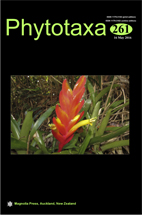Abstract
The hairy-fig complex of Ficus sect. Eriosycea (Moraceae) includes F. hirta, F. esquiroliana, F. simplicissima and a Chinese entity misidentified as F. fulva. These species are difficult to delimit because of the continuously varying morphological characteristics. In order to re-evaluate the status of these taxa, herbarium specimens were extensively examined and 118 samples of the complex were selected for anatomical and molecular analysis. ITS, ETS and trnH-psbA were applied for constructing phylogenetic trees and fluorescently labeled microsatellite primers were screened for cluster analysis. The results showed that all the four species show continuously variable morphological characters and make up one well supported clade on the phylogenetic trees, and that this similar genetic background was confirmed by the cluster analysis. In conclusion, all the four taxa of the hairy-fig complex recorded in China should be combined as one species F. simplicissima, with two varieties: var. simplicissima and var. roxburghii (Miquel) Hong-Qing Li & Jing Lu.

